Our garage-like storage buildings for rolling stock are known by many names. Whatever their labels, they must be weatherproof, critter-proof, and, for some, burglar resistant. How we find the space and how we dress the building to keep it in scale is this column’s topic. I’ll show you 14 examples from Zones 5-10. If you don’t have space on your railway, we have a few options for that situation, too.
Fine features with functionality
Photos 1 and 2 show that raised railways can solve the problems of weatherproof storage with easy access to trains. They elevate car barns to be level with the railway’s track, and keep sidings in scale. Both builders covered sturdy boxes with scale lumber to model prototypes, but the first models a row of historic buildings while the second shows an engine shed with believable details. The first becomes part of the scenery in a large yard, whereas the second lives around the corner from the mainline in a smaller yard.
Don’t you love clerestory windows? Photos 2, 3, and 4 each model a different style to add character and point out a fact of life in train sheds—it’s pretty dark in there without the added roof windows. The windows in photo 3 are long sheets of plastic, framed by arched plywood cutouts. The panes are absent in photo 4, where a warm climate dictates that light and ventilation are needed more than heat retention.
Materials matter to control moisture
The first four pictured “motive-power depots” (as they say in the UK) were built of wood with plastic windows. Other stiffening and strengthening framework keeps them from sagging. All have substantial bases of either wood or concrete (board or cast). Wood should be pressure treated, meaning it should be soaked in a copper compound (a known toxic chemical).
I’ve bought plastic engine houses and reinforced the corners and roof because UV eventually causes degradation, opening the edges to weather. On my first little railway I used a Pola faux-stone engine house (still kicking 20 years later) as the end of my point-to-point line.
Years ago I thought I was smart to store trains in long tunnels, until I was horrified to find that all the metal drivers and wheels had corroded from the ground moisture that kept the air damp (in spite of a so-called dry climate). In one case, irrigation spray hit the train shed, causing housed trains to get misted. To mitigate this, I installed a 40-watt incandescent light bulb to heat the air and drive out moisture. In a wooden engine shed in foggy San Francisco, I installed mini Eva-Dry dehumidifiers that we plug in monthly to recharge.
Unsealed concrete will shed water but any wetness will permeate slowly, making dank conditions inside. Two completely different uses of cast concrete are illustrated in photos 5 and 6. The first (in Canada) uses Precision Board (www.rainbowridgekits.com) reusable formwork to build sides of the building; the second (in Florida) creates a freeform mountain, with two tunnels and a see-through door.
Side-yard storage
Garden railroaders find some ingenious ways to store their trains, based on available space and knowledge of building materials. Photo 7 shows a kind of snow shed sandwiched between a fence and a mountain façade constructed of flagstones; it is a two-level car barn, with doors that open in the front for access, that houses 20′ trains. Photo 8 shows the start of a yet-to-be-covered running shed behind the garden railway.
Whether they cut a hole in the back of the garage or build an interesting train barn, railroaders learn quickly that if all they have to do is open the shed door to run a train, they’re more likely to be out in the garden having fun.
With what materials did you build your scale train shed?
Trevor Park
Santa Cruz, California, Zone 9
Beefed up wooden kit
See related online extra article.
When designing the train yard for the front-yard portion of my Fern Creek & Western garden railroad, I realized that I needed a focal point in the railyard. Since space is limited on our railroad, I knew that a one-stall engine house was what we needed to make a believable engine-repair facility that was suited for a small narrow-gauge railroad.
On a day that we were touring other railroads in our area, my partner and I, who built the FC&W, came across an open house that had a for-sale table: I bought a Lionel #8-82105 Wooden Engine House kit, produced some time in the late 80s and early 90s. Now came the more involved part, building it.
Craig Lund
Denver, Colorado, Zone 5
Recycled metal
See related online extra article.
I like to use “used” items in my railroad. The light fixture, a standard two-bulb unit with all the guts removed, was purchased for $5 at a garage sale. The project manager at a construction site gave me the other metal pieces. Both sources are good for clean, low-cost materials. I used all metal in the construction. Wood can be used but tends to warp and rot. My shed is over-built but will last 100 years. I simply built a metal frame out of perforated angle at the base, and steel 6″ x 1.5″ studs for the sides and ends. This frame gave me something to which I could screw and rivet the outer skin. The height above the doorways is to give the illusion of an overhead crane inside, which all heavy-repair shops would have. My daughter put together a video that showcases the engine shed rather well on our Boxwood Scenic Route Railroad: http://tajialund.com/boxwood-scenic-route-railroad/
Ray Turner
San Jose, California, Zone 9
Acrylic sheeting
See related online extra article.
Most visitors to our house are intrigued by the railroad, having never seen one before, and want to see the trains run. Except for little kids, who will chase the trains for an hour or more, adults just want to see the trains run for five-to-ten minutes. If I had to retrieve engines and cars from the garage and put them on the track, that would take 10 minutes right there, and I wouldn’t be inclined to bother. I think it is valuable to be able to run at least one train within a minute or two, so that I can easily run for a visitor. Thus, I need a train-storage box that I could quickly open, turn the train on, and run. Due to the location of my coal-train shed, people can barely see it, so having no façade makes sense.
Bob Ferrero
Leadville, Colorado, Zone 5
Scratchbuilt wood
See related online extra article.
The engine house still looks great after seven years. [See photo 1 in “Greening.”] The scale-redwood facades are holding up well in our sometimes-hard winters and hot summers but they’re removable if needed for touch-up and repair. My goal is to operate trains anytime, weather permitting, with minimal effort of setup. The engine house was built in two 8′ sections, enabling the ability to move or reposition it to different layouts. The train layout is raised to about 24-30″. The engine house is held level with the track by sitting it on square steel (1½-2″) tubing with the bases in cement. The entire unit stays dry even in blizzard conditions. The result is a layout that can be enjoyed most all the time; just remove the snow from the track and have fun. See photos at www.ncgr.net/ngrc-2015—bob-ferrero—loveland.html
Gary Condry
Wooster, Ohio, Zone 6
Concrete
See related online extra article.
I modeled Cleveland Railway’s Wooster Office and Interurban Car Barn. I bought Quikcrete Vinyl Concrete Patcher, which I use for all my buildings. I used Stoneworks (rrstoneworks.com) flat-sheet siding forms and Stoneworks windows and doors. The windows have diamond panes in them formed by 1/4″ hardware cloth behind the clear plastic. Unfortunately, one can only see it up close or when it’s dark and the lights are on. The garage-door wall is plastic, a better material for fastening doors to such large openings. Now I’m working on the operating system to get the doors to automatically open!





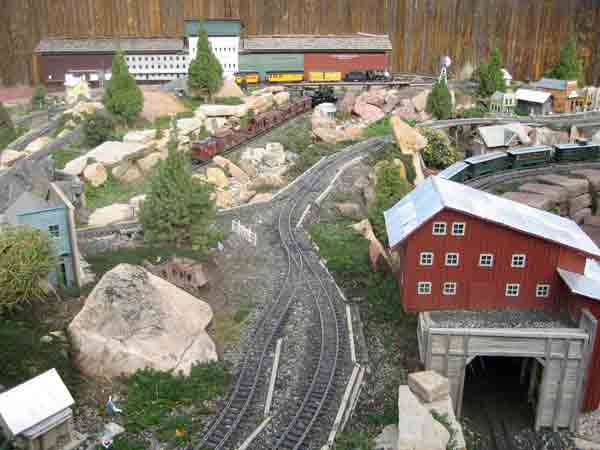
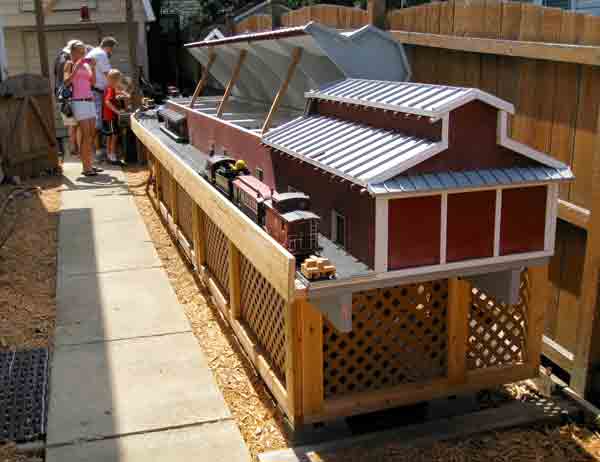
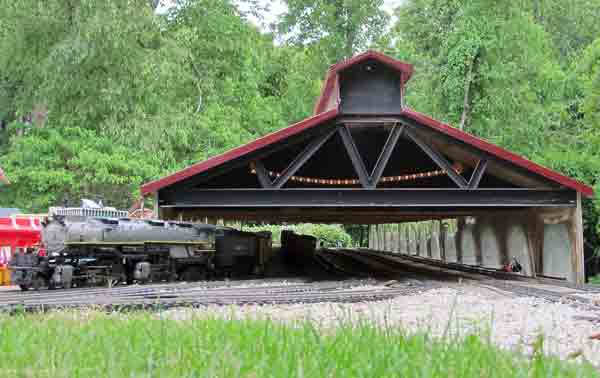
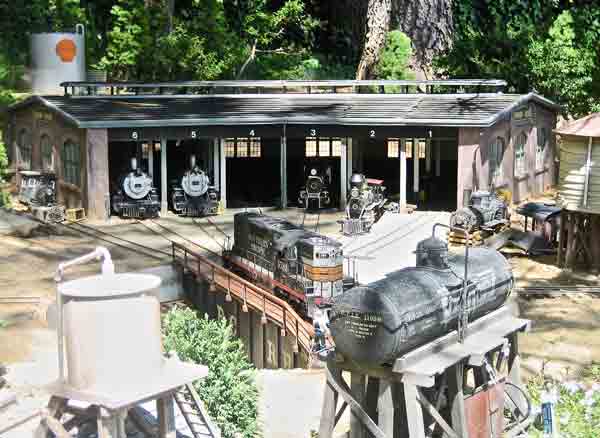
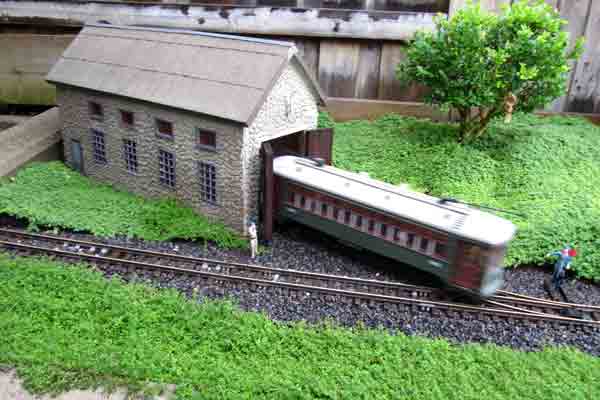
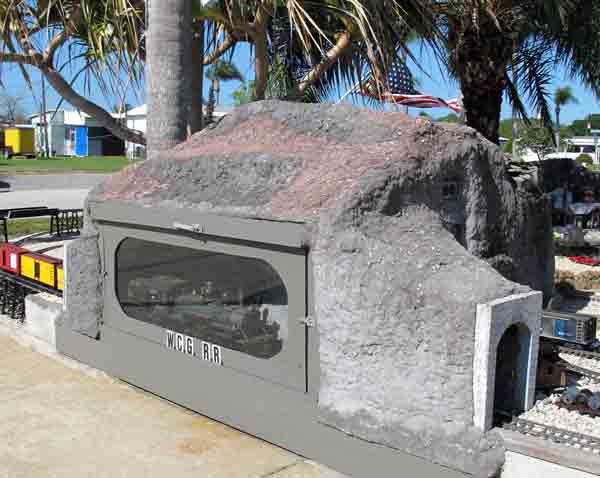
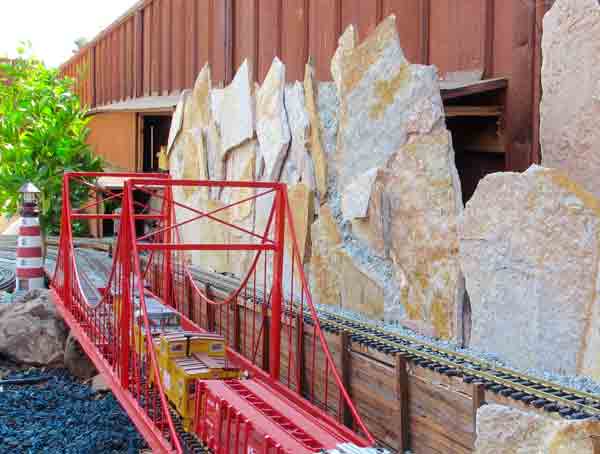
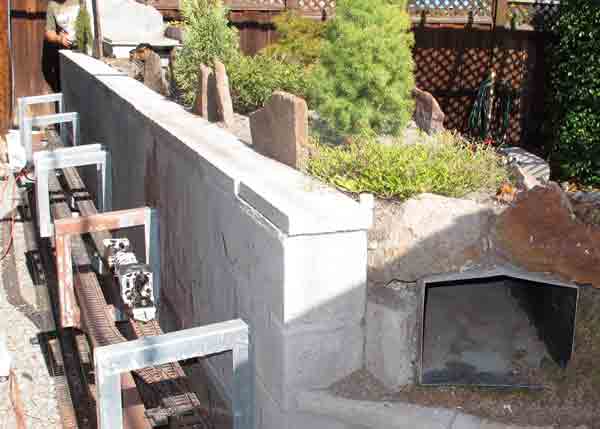
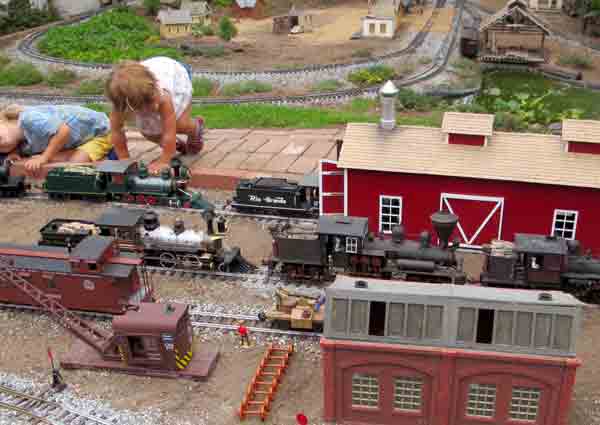
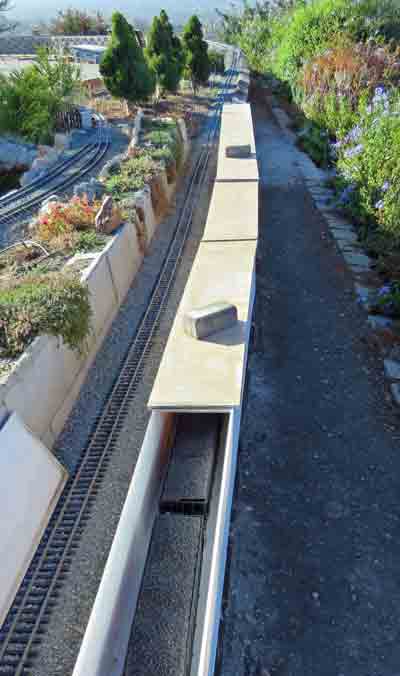
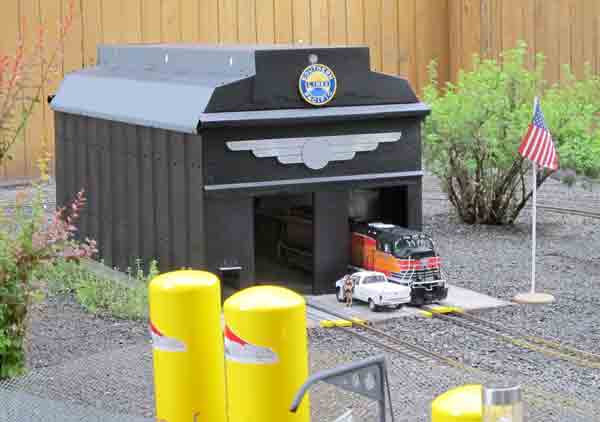
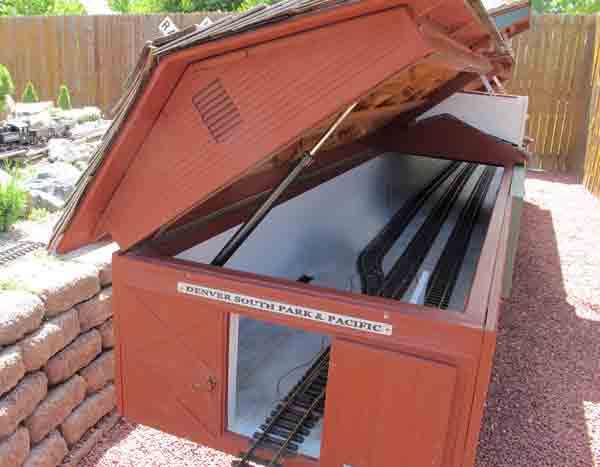
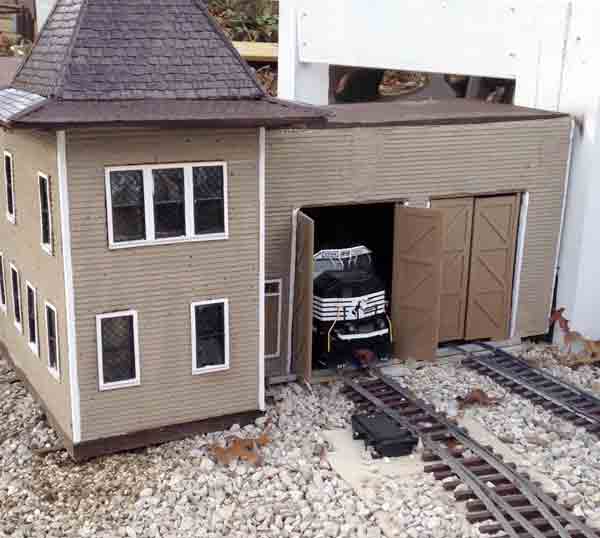

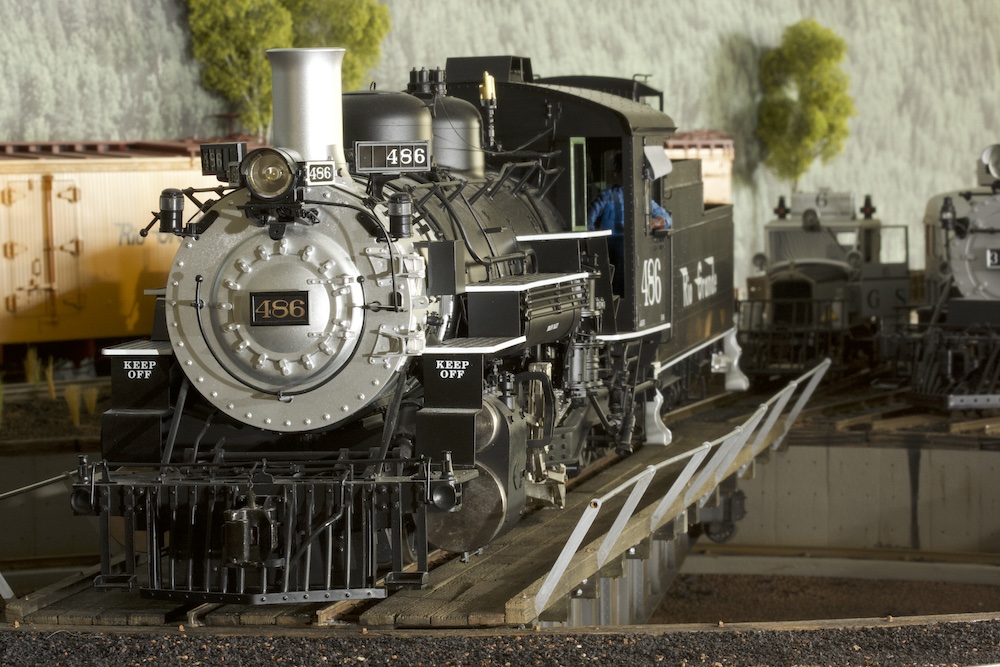
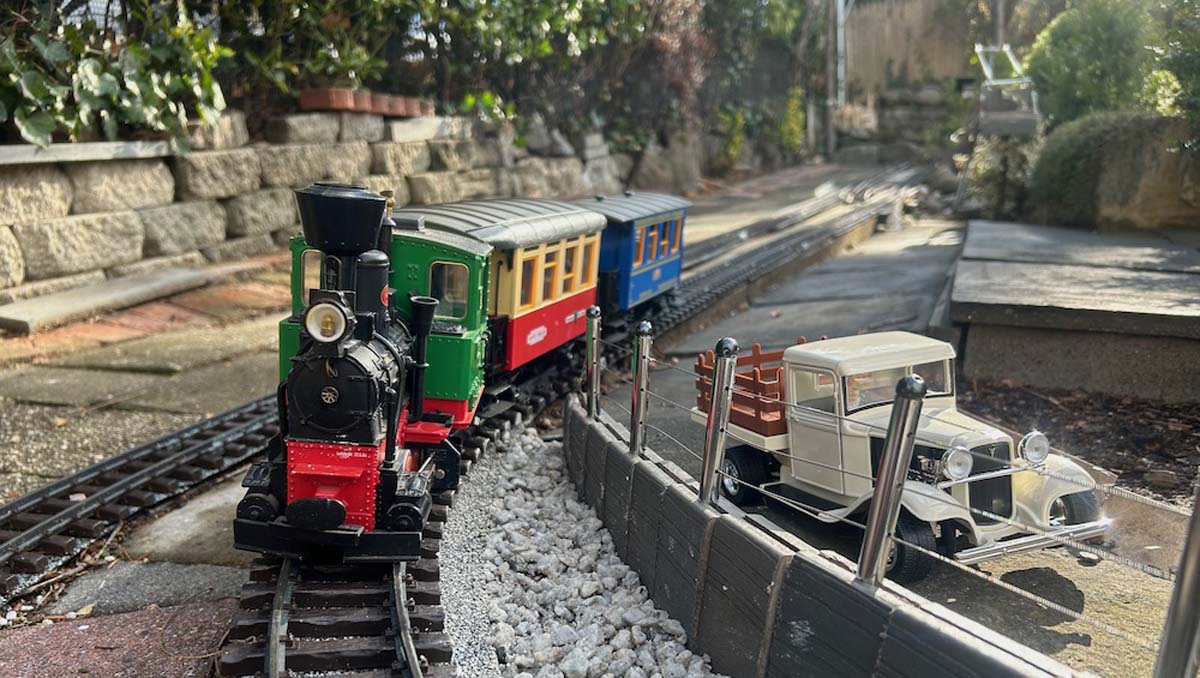
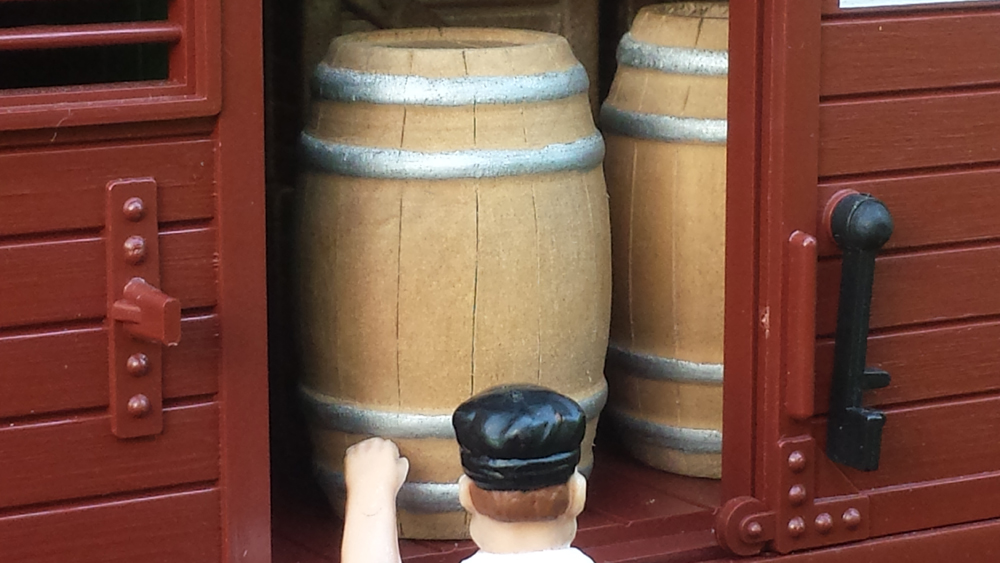
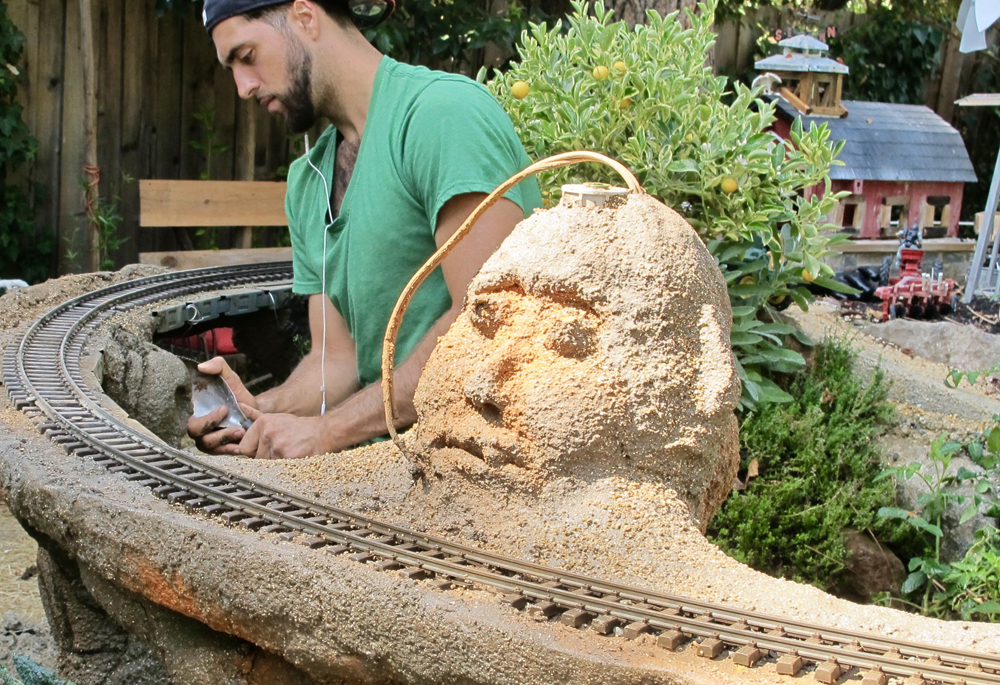




This was an inspiring article of how people store their trains outside in a Car Barn. I made a mountain to have more trains running in my small backyard. It’s on a deck with 3 levels of track. It’s my Car Barn for storing 8 trains. I have LGB Alternating Station for automatic operation with trains running both directions on the main lines. I have an Override Switch to change from Display mode to Shooting Gallery mode. Four Laser (Infrared) Pistols shoot at nine lit Target Cubes on flatcars being pulled on fast moving trains. Here are YouTube videos to see each:
Car Barns
https://youtu.be/cJVQmSQ2X3Q
Target Trains
https://youtu.be/qaS1ok0zXs0